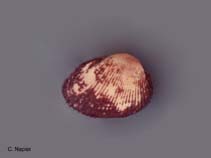Anadara antiquata (Linnaeus, 1758)
Antique ark| Native range | All suitable habitat | Point map | Year 2050 |

|
| This map was computer-generated and has not yet been reviewed. |
| Anadara antiquata AquaMaps Data sources: GBIF OBIS |
Classification / Names Common names | Synonyms | CoL | ITIS | WoRMS
| Arcida | Arcidae
Environment: milieu / climate zone / depth range / distribution range Ecología
; rango de profundidad 0 - 25 m (Ref. 348). Tropical; 36°N - 32°S, 29°E - 23°W
Distribución Países | Áreas FAO | Ecosistemas | Ocurrencias, apariciones | Introducciones
Indo-Pacific: Eastern Africa to Japan, Australia, eastern Polynesia and Hawaii.
Length at first maturity / Tamaño / Peso / Age
Maturity: Lm ? range ? - ? cm Max length : 10.5 cm TL macho / no sexado; (Ref. 348); common length : 7.0 cm TL macho / no sexado; (Ref. 348)
Short description Morfología
Shell inequivalve, solid, inequilateral, obliquely ovate and elongate in outline, with an extended posteroventral part. Umbones much inflated, situated rather forwards, cardinal area narrow and elongate. About 40 radial ribs (35 to 44) at each valve; ribs usually with a narrow median groove on top, most visible towards the anterior ventral margin of valves in mature specimens. Periostracum coarse and velvety, often eroded on umbones. Internal margins with strong crenulations corresponding with the external radial ribs. No byssal gape. Colour: outside of shell greyish white, often stained darker grey on umbonal and posterior areas; periostracum dark brown. Inner side white, sometimes light yellow in the umbonal cavity.
Common on sand (Ref. 75831) and muddy bottoms at intertidal and sublittoral depths to 25 m (Refs. 348, 75831, 128042).
Life cycle and mating behavior Madurez | Reproducción | Puesta | Huevos | Fecundidad | Larva
Members of the class Bivalvia are mostly gonochoric, some are protandric hermaphrodites. Life cycle: Embryos develop into free-swimming trocophore larvae, succeeded by the bivalve veliger, resembling a miniature clam.
Main reference
Referencias | Coordinador | Colaboradores
Poutiers, J.M. 1998. (Ref. 348)
IUCN Red List Status (Ref. 130435)
CITES status (Ref. 108899)
Not Evaluated
CMS (Ref. 116361)
Not Evaluated
Threat to humans
Harmless
Human uses
Pesquerías: comercial
| FishSource |
Herramientas
Más información
Países
Áreas FAO
Ecosistemas
Ocurrencias, apariciones
Introducciones
Stocks
Ecología
Dieta
componentes alimenticios
Áreas FAO
Ecosistemas
Ocurrencias, apariciones
Introducciones
Stocks
Ecología
Dieta
componentes alimenticios
Fuentes de Internet
BHL | BOLD Systems | CISTI | DiscoverLife | FAO(Publication : search) | Fishipedia | GenBank (genome, nucleotide) | GloBI | Gomexsi | Google Books | Google Scholar | Google | PubMed | Árbol de la vida | Wikipedia (Go, búsqueda) | Expediente Zoológico
Estimates based on models
Preferred temperature
(Ref. 115969): 24.7 - 29.3, mean 28.4 (based on 3745 cells).
Resiliencia
(Ref. 69278):
Alto, población duplicada en un tiempo mínimo inferior a 15 meses (K=0.78).



